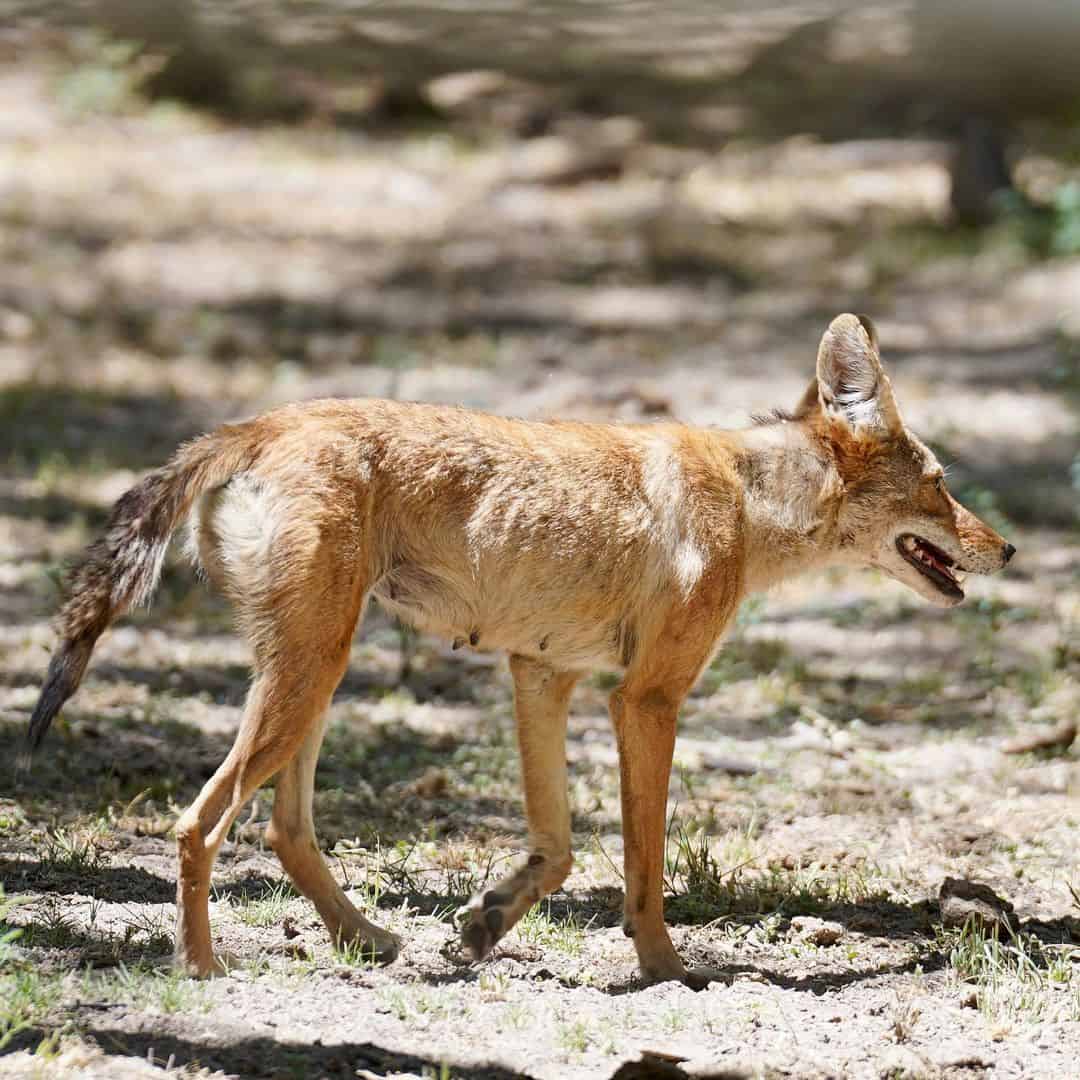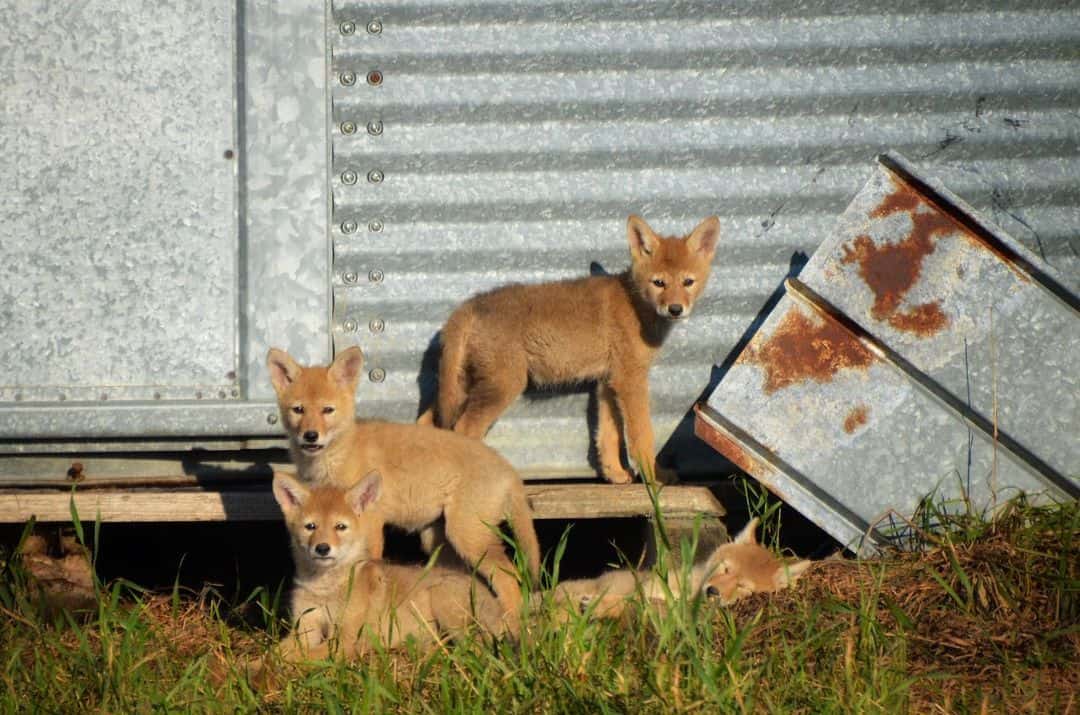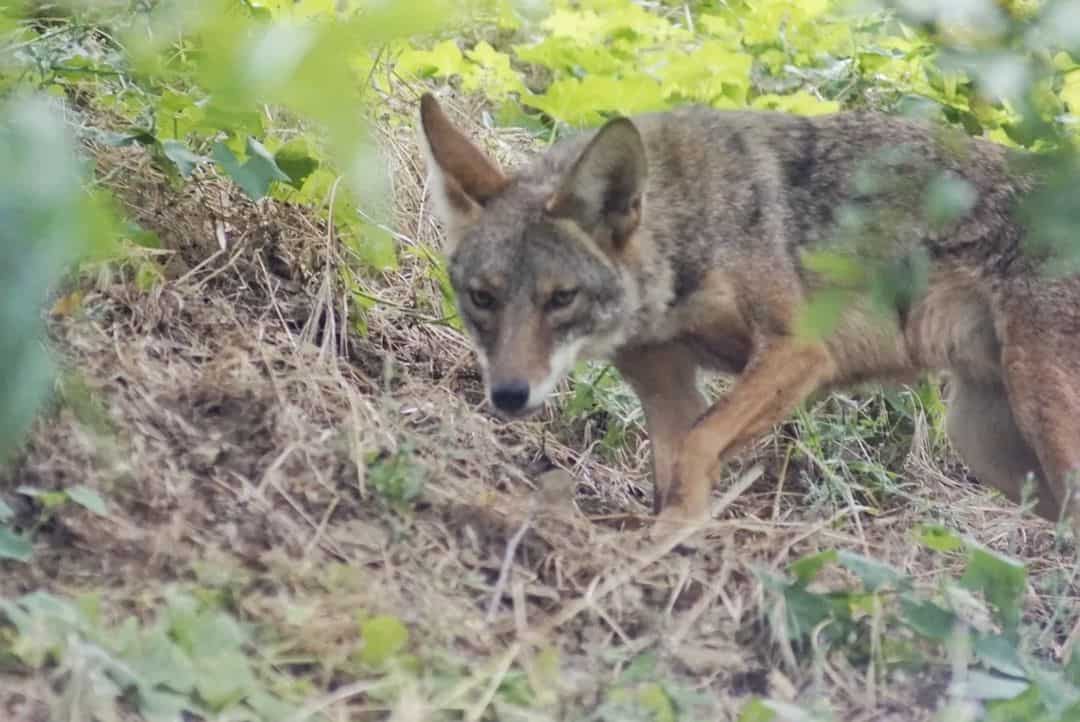No! It’s a common misconception that coyotes hunt in packs like their close cousins: the wolves. But in reality, coyotes are solitary animals.
But why do most articles say so?
Well, before you can develop an article on coyotes, you need extensive knowledge of these creatures- something most bloggers lack. They depend on information curated by other writers rather than scientific research.
Sure, coyotes come together to hunt. But first, you need to know why this happens. And the best way to do that is to know what these animals are, what they consume, and how they live.
So, before we can justify our answer above, let’s first dive into the realm of coyotes.
Brief Overview of Coyotes

Image Credit: tammythetraveler
Native to North America, coyotes (Scientific name: Canis latrans) are medium-sized canines related to wolves, foxes, jackals, and domestic dogs.
These canines share several similarities with the German shepherd, thanks to their bushy, dropping tail, slender muzzles, and upright ears.
As for fur color, coyotes generally have a grayish-brown shade with some yellow-white spots. However, this shade can vary from silver-gray to black.
Its tail, on the other hand, has a black tip, unlike the brown color of most domestic dogs. Coyotes occasionally run with their tail pointing downwards, and they can achieve speeds of up to 65km/h (40 miles per hour).
Coyotes weigh about 9 to 23kg (20 to 50 lbs) and stand 1 to 1.3m (3.3 to 4.3ft) tall.
Do Coyotes Form Packs?
What we know as a “pack” in coyotes is actually a group of related members or a family unit.
Solitary coyotes are usually family members that have left the group to hunt alone or look for a mate.
With that in mind, coyotes have an organized system comprising an alpha male and alpha female, plus their latest pups.
Occasionally, older female siblings from the previous litter will hang around to help raise the next group of pups.
As for the males, their parents chase them out of the territory to prevent inbreeding.
When this happens, the males will venture into other territories looking for food and potential mates to establish a family.
This explains the sightings of lone coyotes roaming the forests, grasslands, and around human settlements.
Can Coyotes Hunt in Packs?
Coyotes are arguably the most successful opportunistic predators. They often change their diet depending on available food sources.
In the wild, coyotes work together as a family to hunt and kill large prey like deer and elk. But they consume small rodents, like mice and squirrels, plus wild birds, insects, snakes, and fruits and vegetables. However, their diet depends mostly on their environment.
In urban and suburban areas, coyotes thrive on human food scraps, roadkill, and sometimes pets.
But due to constant hunting by humans, coyotes have adopted a solitary life. Funny enough, you would think hunting will reduce the coyote population. But it has the opposite effect.
In response to the hunting pressure, all female members of the groups respond by producing at least one litter instead of the whole unit raising puppies of a single alpha pair.
On top of that, they spread out. No wonder their territory today extends from Canada to Central America.
Yes, sometimes they come to hunt together as a family. But they mostly hunt alone or in pairs.
Reasons Coyotes Might Hunt in Packs?
While coyotes thrive as lone hunters, they understand the benefits of cooperation, including:
1. Taking Down Large Prey
Coyotes know that taking down large prey like a white-tailed deer is no easy feat. This is where the rest of the family members come in.
For the best results, the group might use several effective strategies. For instance, each family member might take turns chasing down potential prey. When the prey eventually tires and slows down, the entire family unit swoops in and kills it.
Another clever tactic involves driving the deer into a waiting ambush coyote, usually the fastest and strongest member. The coyote will try to slow or stop the prey until the rest of the group joins him (or her) in taking it down.
These tricks show how intelligent and cunning these canines can get.
2. Territory Protection
Like wolves, coyotes are territorial. While they rarely hunt as a pack, they can band up to defend their territory.
Coyote territories vary based on the habitat and abundance of prey. A typical coyote’s domain covers anywhere from 5 to 15 square miles.
That’s a large territory for one lone coyote to protect. Without support, the canine can become susceptible to threats from other coyote family units or predators like wolves or bobcats.
However, territorial disputes are rare because coyote territories rarely overlap. And multiple coyote families consider areas between territories as the safe zone. So, they have no problem sharing. But remember, this highly depends on the availability of food.
For a lone male coyote, joining a family group or unit is essential. Otherwise, it might cross paths with several alpha males in a hunting zone.
3. Pass Their Knowledge to The Next Generation of Pups

Image Credit: aschlamp
After the mating season (January to March), female coyotes give birth to a litter of 5 to 7 pups.
At first, these pups are blind and helpless. For this reason, they need protection and support from their parents. But after 10 days, the young ones gain eyesight and begin exploring the environment outside the den.
After 35 days, the mother coyote will wean the babies and bring them to small, dead mammals for them to eat.
For 6 months, the pups will learn everything they need to increase their chance of survival. The alpha male and female will take their offspring to meadows and open plains to teach them how to hunt small prey like rabbits.
If you see coyote parents accompanying their pups, it’s easy to mistake the family group for a pack.
But after a while, the young ones stop accompanying their parents. They start venturing out independently to test their hunting prowess. After 9 months, the pups can survive on their own, and their parents can focus on preparing for the next litter.
Through coyote family units, older members can pass their skills, knowledge, and behavior to the next generation of hunters.
How Many Coyotes Form a Family Group or Pack?
Like most canine groups, coyote packs have a unique organization and structure. These units comprise 8 to 10 members that hunt alone or in pairs. But the number of members can vary from year to year.
Remember, all males get kicked out when they mature so they can fend for themselves and establish their group. Because of this, the pack can have as few as 2 members. But when a new litter arrives, the family unit could consist of up to 20 members.
Unlike wolf packs, each member of the coyote pack could have its territory. And occasionally, these territories might overlap. This holds when coyotes come together to hunt bigger prey or fend off a predator.
What’s even interesting is, adult female coyotes might travel in packs in search of mates. If the female finds a pack with a potential alpha male interested in her, she will mate with him for life.
What to Do When You Encounter a Coyote Pack?

Image Credit: fear_n_wonder_shots
An attack from a group of coyotes is rare, but not impossible. In 2009, Taylor Mitchell got attacked and killed by a pack of eastern coyotes while hiking. Another similar case involving a 3-year-old child occurred in 1881.
Since coyote attacks are serious, you need to know what to do when faced with a pack. Below are a few tips to follow:
Don’t run: When you come across a coyote pack, stand on your ground. If you run, you might trigger the coyotes’ instinct to chase. And trust us, you don’t want to do that. Cayotes are agile and super fast, meaning they can catch up and attack before you can reach far. So, maintain eye contact and avoid turning your back.
Make Noises: Scream, whistle, or clap your hands. Coyotes fear humans, so they may feel intimidated. It also helps to throw stones or sticks at the canines while shouting. This sends a message to the coyotes that they should fear you.
Some people may suggest playing dead, but that’s a bad move. Remember, these creatures are opportunistic hunters and such a move will only encourage them to take a bite.
Lastly, if you live in an area with frequent coyote sightings, use repellants to deter them from getting close to your property.
Closing Remarks
As we wrap up, it’s clear coyotes hunt alone or in pairs. However, they might form packs of related members to hunt large prey, fend off predators and protect their territory.
Coyote packs also help in raising the pups and instilling them with the skills and knowledge needed to survive.
When working together, coyotes display remarkable coordination and hunting tactics. This proves their adaptability to changing situations and intelligence.
On that note, it’s time to say goodbye. If you have any questions, inform us in the comment box below.
